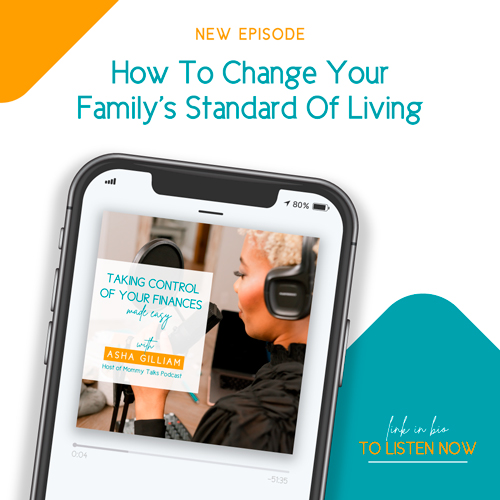MOMMY TALKS PODCAST Episode 19
- MOMMY TALKS PODCAST
Many people work their entire lives only to realize that when they are ready to retire, they don’t have enough saved up to live as comfortably as they once imagined they would, due to inflation over the years.
Everyone that I knew personally—before my mentor—struggled all their lives, never being able to fully attain true financial independence. No one ever took the time to explain to me the importance of understanding how to manage my finances since they had never been taught the significance of doing so.
Taxes are perhaps an employee’s single largest expense each month. The reality of paying taxes first hits you when you receive your very first pay check. It’s at that moment for most of us, that you realize that you don’t get to keep everything you earn. The majority of us then just go through life assuming that it’s normal to pay high taxes and that everyone else is doing so as well.
This is so far from the truth.

Pay Taxes On Your Earnings Now? or Later?

Tax laws were created for everyone, and no one is above the law. But instead of truly understanding tax laws, the poor and middle class tend to focus their energy on despising the wealthy for not paying more in taxes since they make more money.
What they have failed to realize is that they are also able to make money and pay less in taxes simply by understanding the tax laws and learning legal ways to avoid overpaying their taxes.
A successful philosophy I have learned regarding taxes is to pay your share, but not a penny over. There are several vehicles that allow you to defer when you pay taxes on the money you earn. This is tax deferral, which is the postponing of taxes on earnings generated within your investment portfolio.
It allows more of your investment returns to compound over time, resulting in potentially higher long-term returns. You may be wondering, is this even legal? It is.
What are some of those vehicles that allow you to tax defer?
One that we all have heard about by now is a 401(k).
Previously, companies would offer their employees a pension upon their retirement. But the number of companies that offer a traditional pension has dwindled. Workers are increasingly reliant on their own savings to fund their retirement.
In an article written in 2020, only 13 companies in the Fortune 500 offered a traditional pension, or defined-benefit plan, down from the 236 companies in 1998, according to advisory firm Wilson Towers Watson. Companies realized it’s cheaper to offer a small matching contribution to an employee’s 401(k) plan than to fund and pay for the management of a company pension plan.
So, they transferred the burden of funding employees’ retirement to the employees themselves.
Motivational speaker Les Brown says that before we were told to go school, work a job, retire, and receive a gold watch, but those days are over.
Boy was he right, retirement looks very different these days.
"Most companies don't offer 401(k) benefits because of the costs," said Watson, owner of Innovative Kitchen & Bath, a 2018 Big 50 honoree who employs 29 workers. "It's not as expensive as most business owners think because the cost savings with taxes. You either pay the benefit to your employees or pay it to the IRS."
Not only do some employers not see the benefit of offering a 401(k), but many workers do not see the significance of investing in one. Instead, they plan to live solely off their social security that they are due from the taxes they have paid over the years.
And sadly, this thinking is exactly why many people today end up working until their dying day or living their last days according to the terms and conditions set forth by the government. I feel this is due to the lack of understanding of 401(k)s.
So, what is a 401(k)?
Sure, if you work for a company that offers you a 401(k), the company's HR gives you the plan's summary description for review and all necessary forms to complete to participate in the plan. But whose responsibility is it to break it down for you to ensure that you understand all of this?
Sadly, it’s yours and if your financial literacy is limited then you may be like I was, investing in a 401(k) plan but using the money from it when times got hard and not really caring about the taxes you had to pay or the penalty charged for the early withdrawal.
A 401(k) plan is a defined-contribution plan that is also a tax-advantaged, retirement savings account that allows an employee to divert a portion of their salary into long-term investments offered by many employers to their employees.
This means the dividends and capital gains that accumulate inside your 401(k) are not subject to tax until you begin withdrawals. The tax treatment can be a significant benefit if you’ll be in a lower tax bracket in retirement—when you take money out—than you are when you make the contributions.
The IRS requires that all 401(k) plans take a non-discrimination test annually to ensure that highly compensated employees don’t benefit more from tax-deferred contributions.
The companies that do offer a 401(k) plan typically offer employees a choice of several investment options. The options are usually managed by a financial services advisory group such as The Vanguard Group or Fidelity Investments.
- • Traditional plans: A traditional plan offers the flexibility of changing employer contributions each year, according to business conditions.
- • Safe-harbor plans: A safe-harbor plan is different from traditional plans in the sense that it doesn’t require employers to perform annual non-discrimination tests. These tests can be costly, making safe-harbor plans useful for small businesses. However, safe-harbor plans require employers to match employees’ contributions.
- • Simple plans: A simple plan also doesn’t require employers to perform annual non-discrimination tests. This type of plan is entirely exclusive to businesses with 100 or less employees.
- • Solo plans: A solo plan is entirely exclusive to a single participant, like sole-proprietors and freelancers.
The best explanation I have heard of what all this means came recently from Dave Ramsey, America's trusted voice on money, who referred to a 401(k) as the cookie jar that holds the cookies, which are the funds that the employee can choose from to invest their money into.
Most of the options offered usually range from mutual funds, which may include index funds, large-cap and small-cap funds, foreign funds, real estate funds, and bond funds. These options usually range from aggressive growth funds to conservative income funds.
Many, but not all, index funds are structured as mutual funds, and many mutual funds are index funds. The two terms refer to distinct categories. Mutual fund refers to the structure of the fund rather than the investment strategy that the fund’s owners pursue, whereas index fund refers to a fund’s investment strategy.
An index fund is a type of mutual fund with a portfolio constructed to match or track the components of a financial market index, such as the Standard & Poor's 500 Index (S&P 500). An index mutual fund is said to provide broad market exposure, low operating expenses, and low portfolio turnover. These funds follow their benchmark index regardless of the state of the markets.
Index funds are generally considered ideal core portfolio holdings for retirement accounts, such as individual retirement accounts (IRAs) and 401(k) accounts.
Legendary investor Warren Buffett has recommended index funds as a haven for savings for the later years of life. Rather than picking out individual stocks for investment, he has said, it makes more sense for the average investor to buy all of the S&P 500 companies at the low cost an index fund offers.
Standard & Poor's (S&P) is a leading index provider and data source of independent credit ratings. It is also the provider of the popular S&P 500 Index. S&P was founded in 1860, offering financial market intelligence. S&P Global divisions include S&P Global Ratings, S&P Global Market Intelligence, S&P Dow Jones Indices, and S&P Global Platts.
S&P is a major credit risk researcher. It covers multiple industries, benchmarks, asset classes, and geographies. It issues credit ratings on public and private company debt, as well as governments. These include both short-term and long-term credit ratings.
These range in scale from AAA to D. It also offers ratings on short-term debt and provides outlook ratings that range from six months to two years.
The S&P 500 Index launched in March 1957. It was the first index to be published daily, and it is a common benchmark for determining the overall health of the US stock market.
The S&P 500 Index contains 500 of the largest stocks that trade on the New York Stock Exchange and Nasdaq, making it a tool to gauge the overall health of large American companies.
The S&P 500 is probably the single most popular equity index in the world and is used as a performance benchmark for a variety of mutual funds and ETFs.
Other popular indexes offered by S&P Global cover different sectors of the market and different market capitalizations. Large offerings from S&P Dow Jones Indices include the S&P SmallCap 600, the S&P MidCap 400, the S&P Composite 1500, and the S&P 900.
Each represents a look at market health based on its subsector. S&P's major competitors for credit ratings include Moody's and Fitch, and for financial indices, Bloomberg Business Services.
A money market funds investment is considered low risk and low reward, with investments in short-term Treasury notes and Federally guaranteed Bank Certificates of Deposit. There is virtually no investment risk, but the return is usually equivalent to the inflation rate. Any money you think you’ll need within the next year should be invested in a low risk asset where there’s little risk of loss.
A managed fund of corporate or longer-maturity government bonds is generally considered low to medium risk, with low to medium reward. While bond funds lack investment risk (the bonds are paid when they come due), they do bear interest rate risk.
In other words, bond prices vary conversely with the interest rate over time. When interest rates rise, bond prices fall so that new and previously issued bonds have parity in the marketplace.
This means a bond with a face value of $1,000 and a 4% coupon would sell at $667 if interest rates rose to 6%, even though it’s paid at full face value when it matures. Conversely, a bond with a 6% interest rate would sell at $1,500 if interest rates fell to 4%, even though the bond is redeemed at maturity for $1,000.
These assets are perfect for reducing the overall risk of your retirement holdings and should represent an increased percentage of your total portfolio in the five years leading up to retirement.
While balanced funds carry more risk than bond funds due to their common stock exposure, balanced funds also offer greater opportunity for return. As the percentage of bonds within your portfolio rises, the volatility of your portfolio is dampened.
Most balanced funds include a diversified portfolio of mature US large-company common stocks. These companies are usually well-managed, with long histories of profitability.
Their size makes major loss unlikely, just as extraordinary profit is also unlikely (it’s easier to double $1 million in earnings than $100 million in earnings). Balanced funds typically earn at a rate of 2% to 3%, plus inflation, and should be the core holding of most retirement portfolios.
Composed entirely of stock investments, growth fund portfolios typically vary according to the specialty of the fund manager. They can be industry-specific (e.g., technology), a particular stage of company growth (e.g., emerging markets), or focused on company size (e.g., small cap growth).
Growth funds are more volatile than balanced funds—their price varies more day-to-day—so they have higher risk of loss, but greater potential for reward. A growth fund should provide a return of 4% to 5% over inflation to compensate for its increased risk.
No
To be eligible to join the 401(k) plan, an employee must have completed 12 months of service and be 21 years of age or older. The employee may join the plan on the first day of the calendar year quarter following completion of their first year of service—January 1, April 1, July 1, or October 1. Prior to eligibility, the employee will be given the plan's summary description for review and all necessary forms to complete to participate in the plan.
The specific terms of 401(k) plans vary widely. Other than the necessity to adhere to certain required contribution limits and withdrawal regulations dictated by the Employee Retirement Income Security Act (ERISA), the sponsoring employer’s board of directors determines the specific terms of each 401(k) plan.
Dan Stewart, CFA®, president, Revere Asset Management Inc., in Dallas says this may be because, "Your employer could match 100% or even a dollar amount based upon some formula, but this can get expensive and normally owners want their employees to take some ownership of their retirement while still providing an incentive."
Some employers offer a match to the employee contributions up to a percentage of annual income. This limit may be imposed in one of a few different ways. Your employer may elect to match 100% of your contributions up to a percentage of your total compensation or to match a percentage of contributions up to the limit.
About half of employers make matching contributions to their plans, with an average of close to 3% of salary, according to data published by The Vanguard Group in 2019. Many match 50 cents on every dollar of the employee's contribution, up to a limit. And some even add a profit-sharing feature that contributes a portion of the company's profits to the pot as well. If your company offers one or both of these features, sign up for them—they essentially represent free money.
As of 2020 and 2021, the 401(k) contribution limits are $19,500 and $26,000 (includes a $6,500 catch-up for those aged 50 and older), respectively. Your employer can contribute, too. For 2020, that combined limit goes up to $57,000, or $63,500 with the catch-up contribution. In 2021, the contribution limit goes up to $58,000, or (with the $6,500 catch-up) $64,500.
Let’s say you earn a $45,000 salary. If you contribute 6% of your annual earnings ($2,700) to your 401(k), your employer would contribute an additional 50% of that amount. That’s $1,350 of easy money.
Some employers even go one better and match your contributions dollar-for-dollar up to the first 6%, which would add another $2,700 in this scenario, thus doubling your annual contributions to the plan.
That means that the available balance in the account is determined by the contributions made to the plan and the performance of the investments. The employee must make contributions to it. The investment earnings in a traditional 401(k) plan are not taxed until the employee withdraws that money, typically after retirement. After retirement, the account balance is entirely in the hands of the employee.
Experts often recommend saving $1 million before you retire. While that’s more than enough for some, others may not find it sufficient. Still, it’s a helpful rule of thumb as you begin to plan for your retirement needs. To get there, financial planners suggest by the age of 30 that you have saved at least half your annual salary towards your retirement, saving anywhere between 10% and 15% of your gross salary.
To make the process easier (and less expensive), you’ll want to get started early—or earn a substantial salary later on. In many situations, that means bringing in much more than $61,372, the median household income in the US.

When Can You Take Money Out?

Traditional pension plans might have a five-year cliff vesting schedule or a three- to seven-year graded vesting schedule. Vesting is a legal term that means to give or earn a right to a present or future payment, asset, or benefit. It is most commonly used in reference to retirement plan benefits when an employee accrues nonforfeitable rights over employer-provided stock incentives or employer contributions made to the employee's qualified retirement plan account or pension plan.
For some benefits, vesting is immediate. Employees are always 100% vested in their salary-deferral contributions to their retirement plans as well as SEP and SIMPLE employer contributions. Employer contributions to an employee’s 401(k) plan may vest immediately.
Or they may vest after several years using either a cliff vesting schedule, which gives the employee ownership of 100% of the employer’s contributions after a certain number of years or using a graded vesting schedule, which gives the employee ownership of a percentage of the employer’s contribution each year.
Vesting also is commonly used in inheritance law and real estate. In the context of retirement plan benefits, vesting gives employees rights to employer-provided assets over time, which gives the employees an incentive to perform well and remain with a company.
The vesting schedule set up by a company determines when employees acquire full ownership of the asset. Generally, nonforfeitable rights accrue based on how long an employee has worked for a company. One example of vesting is seen in how money is awarded to an employee via a 401(k) company match. Such matching dollars usually take years to vest, meaning an employee must stay with the company long enough to be eligible to receive them.
Just because you are fully vested in your employer’s contributions to your plan does not mean you can withdraw that money whenever you want. But wait, why can’t I take out money as needed? After all, it’s my money, right? You are still subject to the plan’s rules, which generally require you to reach retirement age before making penalty-free withdrawals.

Rules for Withdrawing Money

Retirement funds are retirement funds for a reason, so you probably shouldn’t be looking to withdraw from it until the time is right. That being said, you typically can’t tap into your 401(k) until you’ve reached the age of 59 ½. Doing so beforehand will lead to a 10 percent tax penalty on top of the usual tax bill that comes with traditional 401(k) plans. This is a hefty amount of lost money.
However, while an IRA withdrawal doesn't require a rationale, a triggering event must be satisfied to receive a pay out from a 401(k) plan.
The following are the usual triggering events:
- The employee retires from or leaves the job.
- The employee dies or is disabled.
- The employee reaches age 59½.
- The employee experiences a specific hardship as defined under the plan.
- The plan is terminated.










